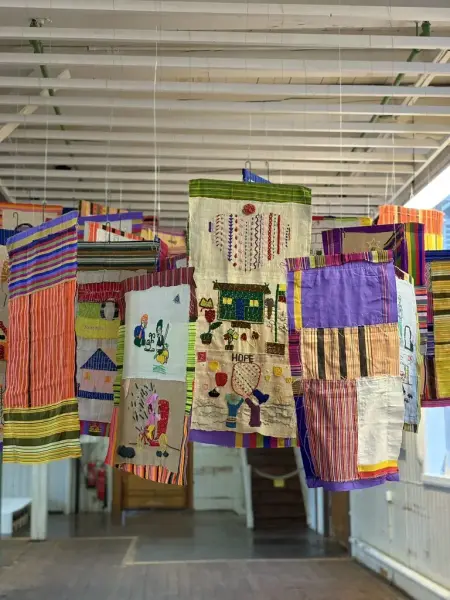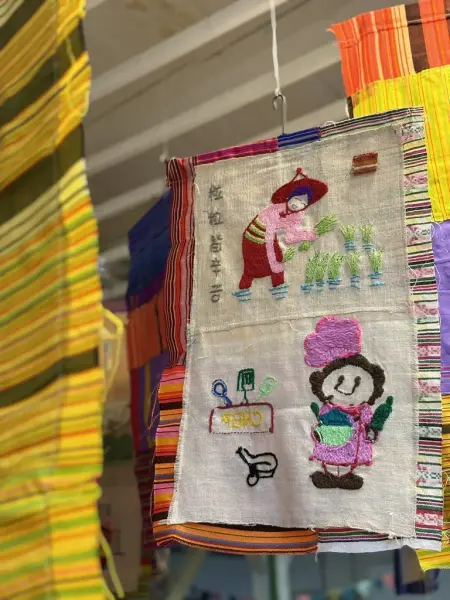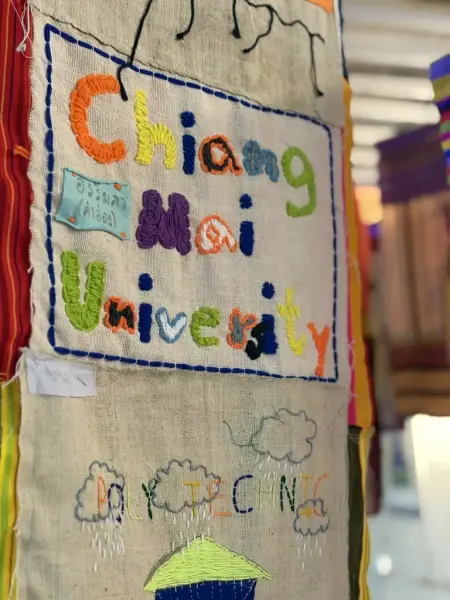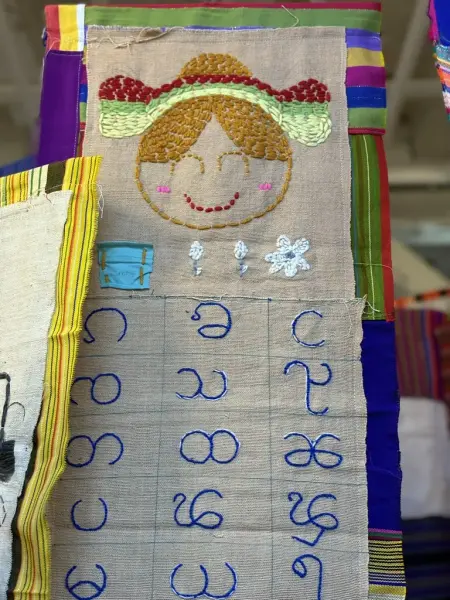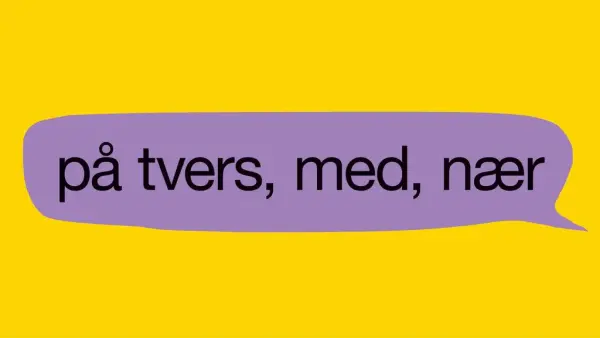There's no place av Jakkai Siributr
Scroll down for English
Jakkai Siributrs langvarige tekstilprosjekt tematiserer hvordan nasjonalstater og kolonialisme har påvirket urfolksgrupper. Shan-folket regnes som Myanmars største minoritet, og mange lever i eksil i høylandsområder i Sørøst-Asia. De har flyktet fra år med diskriminering og vold, og nektes ofte arbeid og grunnleggende helsetjenester.
𝘛𝘩𝘦𝘳𝘦’𝘴 𝘯𝘰 𝘗𝘭𝘢𝘤𝘦 består av tekstilbannere og en serie verksteder som viderefører prosjektet. Hver tekstil kan berøres, endres og tolkes på nytt av publikum og deltagerne i verkstedene. For å utfordre ideen om den individuelle kunstnerens eierskap, inviteres besøkende til å brodere inn egne svar med tråd i svart, hvit og grå tråd, i form av motiver, detaljer eller personlige meldinger. Broderiene åpner opp for refleksjon, dialog og medskaping. Gjennom møtet mellom ulike mennesker og steder oppstår nye forbindelser — mellom det nære og det fjerne, det personlige og det kollektive. Verket er et uttrykk for poetisk kunnskap, gjennom temaer som naboskap og kjærlighet som en sosial kraft, og skaper nærhet mellom mennesker med ulik bakgrunn og erfaring.
Tekstilene stilles ut samlet og danner et tak av ulike størrelser som skaper et skjermet rom der kollektive historier fra forskjellige samfunn kan tre frem og berøres. På Tekstilindustrimuseet har prosjektet utviklet seg videre gjennom verksteder som skal bidra til nye lag av minner, arbeid og stedsforankring.
Bli med på workshop i utstillingen sammen med kunstner Jakkai Siribur lørdag 25. og søndag 26. oktober kl. 13:00-16:00. Reserver gratis billett her.
-
Kunstner: Jakkai Siributr Tekstilindustrimuseet
Praktisk informasjon
Åpningsdager: 11.–14. september 2025
Utstillingsperiode: 11. september–9. november 2025
Sted: Spoleloftet, Tekstilindustrimuseet, Salhusvegen 201
Gratis inngang i utstillingen
Åpningstider fra 17. september - 9. november:
- onsdag-fredag 11-15
- søndag 12-17
- åpent lørdag 25. oktober kl. 12-16 i samband med workshop med Jakkai Siributr
Jakkai Siributr (f. 1969, Bangkok)
Jakkai Siributr utforsker møtet mellom tradisjon og samtid gjennom tekstilkunst. Han er særlig kjent for sine detaljerte, håndlagde tepper, quilter og installasjoner som gir sterke kunstneriske svar på både historiske og aktuelle spørsmål i Thailand.
Siributrs broderte installasjoner tar opp temaer som vold, religiøse symboler, migrasjon, identitet og personlige minner.
I 2021 startet han prosjektet Phayao-a-Porter, som støtter håndverkere og assistenter som mistet livsgrunnlaget sitt under pandemien. Her samarbeider han med kunsthåndverkere fra Phayao-provinsen i Nord-Thailand om å gi nytt liv til brukte plagg gjennom unike, figurative applikasjoner. Hele 30 % av salget går tilbake til lokalsamfunnet – i form av stipend, helsetiltak og nødhjelp.
I tillegg samarbeider Siributr med Shan Youth Organization i Nord-Thailand. Han bor og arbeider i Bangkok og Chiang Mai.
-
Tekstilindustrimuseet
English information
Jakkai Siributr’s long-running textile project speaks to the impact of nation-states and colonialism on indigenous groups. Considered the largest minority group in Myanmar, Shan are a displaced population that is often relegated to Southeast Asia’s upland region. They have fled decades of discrimination and violence and are often denied employment and basic healthcare.
𝘛𝘩𝘦𝘳𝘦’𝘴 𝘯𝘰 𝘗𝘭𝘢𝘤𝘦 is comprised of textile banners and also offers a series of workshops that continue the project. Each piece may be touched, altered, and reinterpreted by viewers and workshop participants. Resisting fixed authorship, anyone and everyone can participate in stitching the narrative using black, white, and grey threads, adding scenes, details, or personal messages. The imagery is therefore an invitation to engage. Moving across different places and people, identification and conversation are nurtured to create a relationship between intimacy and distance. The work is an embodiment of poetic knowledge, by means of neighbouring and love as a public force, as it creates closeness between distant groups of people with varying experiences.
The banners are different sizes and hang overhead to resemble a shelter under which the collective histories of disparate communities can be touched. In Salhus the project is expanded via workshops for former textile workers and local communities, adding new layers of memory, labour, and experiences.
Jakkai Siributr (b. 1969, Bangkok) works with textiles to explore the connections between tradition and modernity. He is specifically known for his intricate, hand-made tapestries, quilts and installations, which convey powerful responses to contemporary and historical issues in Thailand.
Siributr’s embroidered installations reflect on themes of violence, religious symbolism, migration, identity, and personal memory. In 2021, he launched Phayao-a-Porter, a project that supports artisans and studio assistants whose businesses and livelihoods have been affected by the COVID-19 pandemic.
As part of this, his studio works with artisans from Phayao Province in northern Thailand to embellish second-hand garments with unique figurative appliqué designs. Thirty percent of the sales of each jacket go back to the local community in the form of scholarships, health care, and relief efforts. Siributr also currently works with the Shan Youth Organization in Northern Thailand. He lives and works in Bangkok and Chiang Mai.
Join a workshop with Jakkai Siributr October 25 and 26. Read more and book a free tickets here.
Practical information:
Opening Days: 11–14 September 2025
Exhibition Period: 11 September – 9 November 2025
Free enctrance to the exhibition
Venue: Spoleloftet, The Textile Industry Museum, Salhusvegen 201
Opening Hours from 17 September – 9 November:
- Wednesday–Friday: 11:00–15:00
- Sunday: 12:00–17:00
- Open Saturday October 25 12:00-16:00
-
Bergen Assembly
Om Bergen Assembly:
Bergen Assembly er en fleksibel modell for kunstproduksjon som leder frem til offentlige arrangementer i Bergen hvert tredje år. Hver treårssyklus ledes av en eller flere convenere som står fritt til å utforme og organisere prosjektet slik de ønsker, og kan derfor ha helt ulik karakter fra gang til gang.
Bergen Assembly ble etablert i etterkant av Bergen Biennial Conference, som fant sted i 2009 som svar på Bergen kommunes forslag om å etablere en internasjonal biennale for samtidskunst. Konferansen, der internasjonale kuratorer, kunstnere og akademikere diskuterte spørsmålet «To biennial or not to biennial?», resulterte i The Biennial Reader (Hatje Cantz/Bergen Kunsthall, 2010) – til dags dato den mest omfattende publikasjonen om biennalers og periodiske utstillinger og arrangementers historie og praksis i et globalt perspektiv.
Tema for årets utstillinger er på tvers, med, nær
Hva vil det si å dyrke naboskap både nær ved og på avstand? Hva skal til for at kjærlighet kan forstås som en sosial kraft som motvirker økologisk, økonomisk og politisk urett? Hvordan kan vi utfordre læringsmønstre som visker ut mangfoldet av verdener, kunnskapsformer og væremåter?
Den femte utgaven av Bergen Assembly inviterer deg til å nærme deg disse spørsmålene ved å utforske læring på tvers, med, nært. Vårt mål er å skape kollektive og personlige motsvar til den lammende usikkerheten og brutaliteten som omgir oss i dag. Felles refleksjon over nye innsikter, så vel som ideer som for lengst har gått i glemmeboken, kan gi rom for kreative former for usikkerhet.
Spørsmålene springer ut av de ulike prosjektene som knyttes sammen i denne utgaven av Bergen Assembly, utformet av Ravi Agarwal, Adania Shibli og Bergen Arkitekthøgskole (BAS). Du kan bli med på å videreutvikle og reformulere dem ved å delta i Bergen Assemblys kommende program. Denne utgaven vil være erfaringsbasert: En levende prosess der poenget er å skape og dele kunstneriske og kunnskapsbaserte uttrykksformer, heller enn å vise frem.
på tvers, med, nær tar utgangspunkt i forestillinger om omsorg og gjensidighet. Prosjektet samler kunstnere, forfattere, arkivarer, aktivister, arkitekter og flere som undersøker hvordan vi kan lære sammen med andre. Men når kunnskap springer ut av levd erfaring og gjensidig utveksling, kan vi også bli eksponert for usikkerhet, intimitet og sårbarhet. Dette kommer til uttrykk gjennom verk man kan se og høre, og mer performative prosjekter som åpner for gjestfrihet, fellesskap og naboskap.
Agarwal, Shibli og Bergen Arkitekthøgskole fokuserer på kunnskapsformer som er under utvikling og som også kan kobles til hverandre: I all sin kompleksitet kan de minne om det Aimé Césaire kalte «poetisk kunnskap». Det vesentlige her er en form for læring som ikke går inn for å definere eller avgrense, men som utvikles langsomt i møtet mellom konkrete steder, mennesker og livsformer. på tvers, med, nær inviterer deg til å oppdage det usette i det velkjente og søke nye former for tenkning og handling, i Bergen og andre steder.
Med:
Ken Are Bongo og Joar Nango, Susan Philipsz, Koki Tanaka, Prabhakar Pachpute, og Jana Winderen på Bergen Arkitekthøgskole. Vikrant Bhise, Marcus Coates, AgriForum: Acts of Re/Collection (tilrettelagt av FICA, med bidrag av Anga Art Collective, Malavika Bhatia, Ankan Dutta, Sanchayan Ghosh, Blaise Joseph, Rashmi Kaleka, Shubham Kumar, Maksud Ali Mondal, Ashis Palei, Bhikari Pradhan, Gopa Roy, Sheshadev Sagria, Niroj Satpathy, Umesh S, og Gyanwant Yadav), Kåre Aleksander Grundvåg, Gram Art Project og Matskogen, Clara Hastrup, Ánddir Ivvár Ivvár / Iver Jåks, Sajan Mani, Gruppe 66, Karen Werner, Singing Wells, og Karan Shrestha, og co-ritus arrangement av Susan Philipsz, Maasai Mbili, Jakkai Siributr, og Tenthaus Art Collective på Bergen Kunsthall. Izz Aljabari, Priya Bains, Olav Bleie, Blocknotes med Christine Otten og Mohamedou Ould Slahi, Tora Sanden Døskeland, Leander Djønne, Shahram Khosravi, Lars Korff Lofthus, Layli Long Soldier, Maaza Mengiste, Christine Elsebet Rahlff, Agnes Ravatn, Philip Rizk, Einar Økland, Gunnhild Øyehaug, Elin Már Øyen Vister, og Hardangerfjord miljøet på Litteraturbåten Epos. Nepal Picture Library: Dalit Archive, Feminist Memory Project, PARI Archive (Grindmill Songs Project), og Skeivt Arkiv på Stranges Stiftelse. INTERPRT and Climate Rights på Bergen Offentlige Bibliotek og MLAG. Monica Ursina Jäger på Grand Hotel Terminus, Amundsen Bar. Maasai Mbili Artist Collective på Entrée. Floating University på Kristiansholm. Builders’ Hut og Trajectories på ROMMET, USF. Communist Museum of Palestine og Tenthaus Art Collective med Ayreen Anastas, Rana Anani, Rana Batrawi, Munir Fasheh, Rene Gabri, Mandaloun Collective, Mezna Qato, og andre på P1 Mobile Studio på Bergen Katedralskole ‘Katten’. Lapdiang Artimai Syiem og Monica Ursina Jäger på Nonneseter. Al Borde og Traces på Bergen Assembly Åpent kontor. Jakkai Siributr og Erlend O. Nødtvedt på Tekstilindustrimuseet. Sarah Kazmi på Fiskerimuseet. Hans Petter Blad, Pedro Carmona-Alvarez, Shwan Dler Qaradaki, Ulla Schildt, Kjersti Annesdatter Skomsvold, og andre i Vinduet.
Også på trykk i: Vinduet, Klassekampen og Cabinet Magazine.
